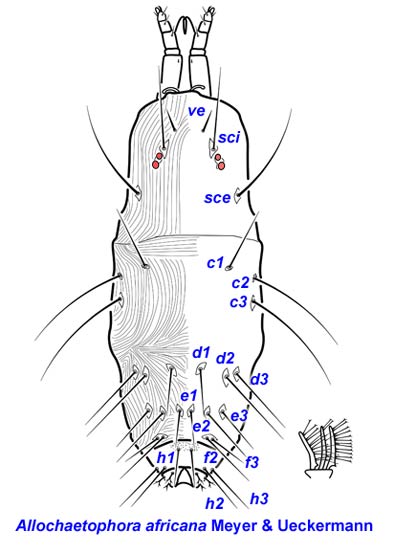Tetranychoidea: Allochaetophoridae
Superorder Acariformes
Order Trombidiformes
Suborder Prostigmata
Supercohort Eleutherengonides
Cohort Raphignathina
Superfamily Tetranychoidea
Family Allochaetophoridae
Common names:
Probability of Encounter: Low
Quarantine importance:
Low. The Allochaetophoridae consists of a single genus, Allochaetophora,
with two described species, one from California (from the deutonymph) and one
from Africa (all stages). Both are associated with grasses.
Diagnosis:
-
Empodium & claws with tenent hairs.
-
Prodorsum with 3 pairs of setae (ve, sci, sce)
-
Adult female with 3 pairs of distally divided anal setae (males with 3 pairs of simple ano-genital setae).
-
Cheliceral bases adnate, fused mesally into a stylophore (sometimes withdrawn into the body); chelicerae with fixed digit reduced and movable digit whiplike.
-
Peritremes emergent on anterior edge of prodorsum; naso absent; prodorsal trichobothria absent; 2 pairs of eye lenses present. Palps 5 segmented; with thumbclaw process (claw-like seta on the palp tibia and a thumb- or button-like subterminal palp tarsus). Leg tarsi with tenent hairs on claws and empodium. Genital papillae absent; males with an intromittent aedeagus.
Similar taxa. Allochaetophorids resemble other elongate tetranychoids such as linotetranids (which are blind) and some Tenuipalpidae (which lack a thumbclaw process).
Ecology & Distribution. The Allochaetophoridae consists of a single genus, Allochaetophora, with two described species, one from California (from the deutonymph) and one from Africa (all stages). Both are associated with grasses.
References
Meyer, M.K.P.S. & E.A. Ueckermann 1997. A review of some species of the families Allochaetophoridae, Linotetranidae and Tuckerellidae (Acari: Tetranychoidea). International Journal of Acarology 23: 67–92.